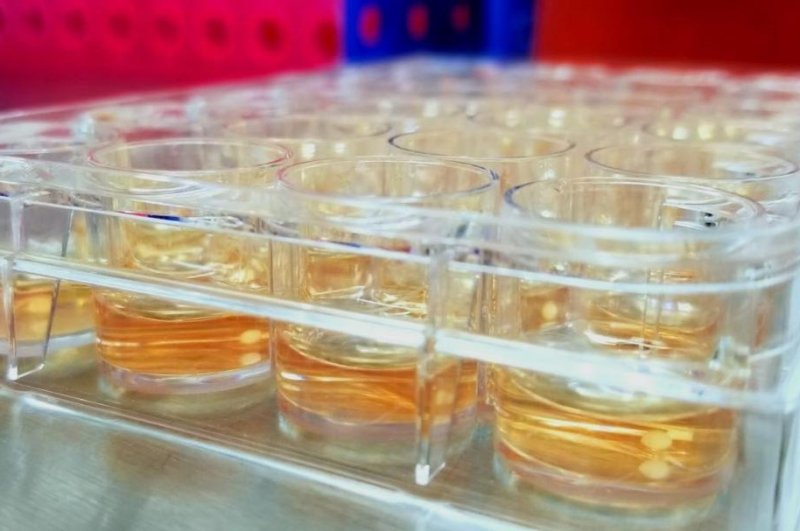Researchers for the first time managed to grow brain organoids in laboratory dishes, which are self-organizing mini-spheres that contain all the major cell types found in the human cerebral cortex. Photo courtesy of Case Western Reserve University School of Medicine
July 25 (UPI) -- Scientists have determined how drugs can repair damaged brain cells that cause disability in people with multiple sclerosis, and possibly other degenerative neurological diseases.
In separate labs at Case Western Reserve University School of Medicine, the researchers gained new insights into how the body makes myelin, which is a fatty substance serving as a protective sheath that surrounds nerve cells and helps transmit electrical impulses in the brain and spinal cord.
The researchers confirmed their findings, which were published separately Wednesday, in mouse stem cells, mouse brain cells, patient-derived stem cells and in a new 3D cell culture model.
In one study, published in the journal Nature Methods, they demonstrated how to grow brain organoids in laboratory dishes, which are self-organizing mini-spheres that contain all the major cell types found in the human cerebral cortex.
The other study, published in the journal Nature, identified more than 20 new drugs that enhance myelin formation by inhibiting closely related cholesterol-producing enzymes. They found these drugs, which were previously identified by labs across the world as enhancing new myelin, also reflected these same enzymes.
"These two studies emerged from a unique marriage of stem cell biology and chemical biology in our adjacent labs, with the overarching goal of identifying regenerative therapeutics for patients with multiple sclerosis," Dr. Drew Adams, a professor of novel therapeutics and assistant professor of genetics and genome science at Case Western, told UPI.
Adams studied how drugs work to replenish myelin that was destroyed by multiple sclerosis. A repair process is overwhelmed as the disease progresses -- though it has some ability to regenerate new myelin during the early stages.
"Nearly all early-stage drug candidates aimed at regenerating myelin surprisingly function by altering how brain stem cells make cholesterol, both in mice and in the human brain organoids," he said.
In the lab, scientists studied how growing organoids could assist in studying myelin.
"Previous work from my lab identified therapeutics that could regenerate myelin and reverse paralysis in mouse models of multiple sclerosis," Dr. Paul Tesar, a professor of innovative therapeutics as well as genetics and genome science, told UPI. "What we lacked was understanding of how these potential medicines worked in mice and whether they would have similar benefit in human brain tissue."
Organoids, which mimic an organ, are becoming a way for researchers to study development of healthy organs as well as study disease.
"Since the human brain is typically inaccessible, organoid technology enables us to generate human brain-like tissue in the laboratory," Tesar said. "Our study in Nature Methods demonstrates a new human brain organoid platform that may help predict the safety and efficacy of new myelin therapeutics in the laboratory prior to clinical testing in patients.
They identified a family of three enzymes that triggers a chemical cascade resulting in the production of additional myelin when blocked.
Using high-level screening technology, they isolated a new mechanism found in drug compounds known to remyelinate nerve cells.
"We have taken the organoid system and added the third major cell type in the central nervous system -- oligodendrocytes -- and now have a more accurate representation of cellular interactions that occur during human brain development," Tesar said in a press release.
Oligodendrocytes make myelin. Without it, nerve cells deteriorate because they can't communicate effectively. Because of these defects, many neurological diseases, including MS and rare pediatrictric disorders, can emerge.
"This is a powerful platform to understand human development and neurological disease," Tesar said. "Using stem cell technology we can generate nearly unlimited quantities of human brain-like tissue in the lab. Our method creates a 'mini-cortex' containing neurons, astrocytes and now oligodendrocytes producing myelin. This is a major step toward unlocking stages of human brain development that previously were inaccessible."
Also, organoids were generated from patients with Pelizaeus-Merzbacher disease, which is a rare and fatal genetic myelin disorder.
In the other study, researchers found several drugs accelerated myelin repair in mice with a version of MS. In subsequent experiments, more than 20 drugs enhanced the formation by inhibiting the cholesterol-producing enzymes.
"We were shocked to find that almost all of these previously identified molecules share the ability to inhibit specific enzymes that help to make cholesterol," Adams said in a press release. "This insight reorients drug discovery efforts onto these novel druggable targets."
In 2015 research by Tesar, he identified a drug that treats athlete's foot, called miconazole, was a potential enhancer of new myelin.
Clinical trials are expected sometime in 2019, the authors said.
"While the path to patients is never certain, we are working diligently with our academic and commercial partners to develop safe and effective medicines for remyelination in the near term," Tesar said.















